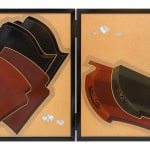Ikeda Kiichi
Lacquer Folding Screen with Roof Tiles, 1952
Maki-e gold and colored lacquer on wood with shell inlays
Size 22¾ x 71¾ x ¾ in. (57.7 x 182.2 x 1.7 cm)
T-4811
Further images
-
(View a larger image of thumbnail 1
)

-
(View a larger image of thumbnail 2
)

-
(View a larger image of thumbnail 3
)

-
(View a larger image of thumbnail 4
)

-
(View a larger image of thumbnail 5
)

-
(View a larger image of thumbnail 6
)

-
(View a larger image of thumbnail 7
)

-
(View a larger image of thumbnail 8
)

-
(View a larger image of thumbnail 9
)

A low two-panel byobu (folding screen) worked in colored lacquer with shell inlay depicting ten black or ochre kawara (ceramic roof tiles), some with impressed decoration Exhibited: Eighth Nitten Exhibition,...
A low two-panel byobu (folding screen) worked in colored lacquer with shell inlay depicting ten black or ochre kawara (ceramic roof tiles), some with impressed decoration
Exhibited:
Eighth Nitten Exhibition, Tokyo Metropolitan Art Museum, Ueno Park, Tokyo, October 29–December 1, 1952
Published:
Nittenshi Hensan Iinkai (Nittenshi Editorial Committee), Nittenshi 17 (History of the National Salon 17), Nitten hen 2 (The Nitten Exhibition 2), Tokyo, Nitten, 1987, pp. 356, 370 (no. 30)
Born in Kaga City, an ancient center of lacquer craft, Ikeda Kiichi studied under several local masters before showing his work at national level from 1949 at the Fifth Nitten exhibition. That piece was a tebako (formal accessory box) but at the next three Nitten exhibitions he showed ambitious lacquer byōbu (folding screens): first, in 1950, a dramatic composition of rocks and boulders; second, in 1951, scattered logs of charcoal; and finally in 1952 the present screen with its inventive tile design. Ikeda is noted for his success in breathing new life into the venerable tradition of Kaga maki-e (lacquer ware with sprinkled gold powder designs made in Kaga Province [present-day Ishikawa Prefecture]), often using motifs that reflect local crafts and customs.
Exhibited:
Eighth Nitten Exhibition, Tokyo Metropolitan Art Museum, Ueno Park, Tokyo, October 29–December 1, 1952
Published:
Nittenshi Hensan Iinkai (Nittenshi Editorial Committee), Nittenshi 17 (History of the National Salon 17), Nitten hen 2 (The Nitten Exhibition 2), Tokyo, Nitten, 1987, pp. 356, 370 (no. 30)
Born in Kaga City, an ancient center of lacquer craft, Ikeda Kiichi studied under several local masters before showing his work at national level from 1949 at the Fifth Nitten exhibition. That piece was a tebako (formal accessory box) but at the next three Nitten exhibitions he showed ambitious lacquer byōbu (folding screens): first, in 1950, a dramatic composition of rocks and boulders; second, in 1951, scattered logs of charcoal; and finally in 1952 the present screen with its inventive tile design. Ikeda is noted for his success in breathing new life into the venerable tradition of Kaga maki-e (lacquer ware with sprinkled gold powder designs made in Kaga Province [present-day Ishikawa Prefecture]), often using motifs that reflect local crafts and customs.








